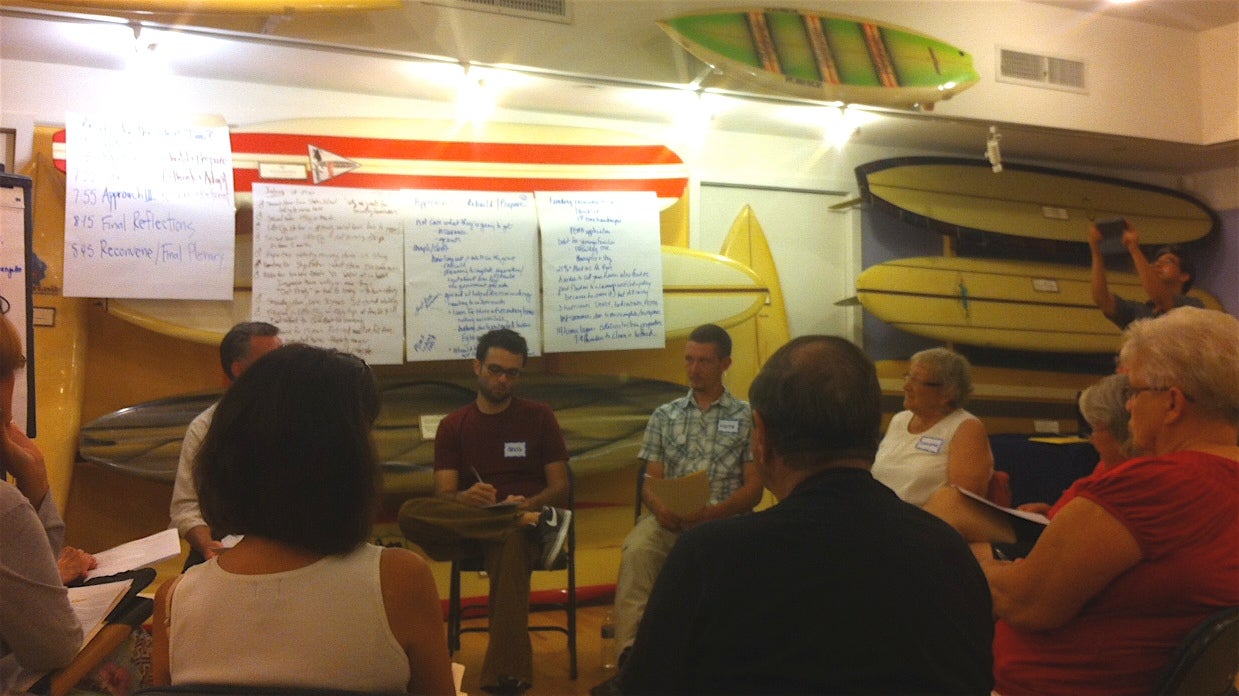Finding little help or sympathy post-Sandy, second homeowners are speaking up

During a breakout session in the NJ Surf Museum section of the Tuckerton Seaport, full- and part-time residents talked about how to move on after Sandy and prepare for future storms. / Photo by Amy Z. Quinn
While some Jersey Shore residents who suffered property damage or loss because of Superstorm Sandy are beginning to receive aid money and insurance settlements, and homes are being lifted all along the coast, secondary homeowners have largely been left to fend for themselves.
In some neighborhoods, properties sit untouched and unrepaired, while their owners live elsewhere. It’s frustrating to full-time residents, who fear declining property values.
But for many middle-class families who own second homes at the Shore, it’s frustrating on their end, too. Insurance settlements are slow and state laws make it difficult dispute inadequate ones. Aid money is largely nonexistent, and since most seasonal residents don’t vote in New Jersey, lawmakers aren’t exactly tripping over themselves to help.
Some, like Karen Sabella, of Staten Island New York and Mystic Island New Jersey, are beginning to speak up.
I met Sabella Tuesday night at WHYY’s Ready For Next Time? forum at the Tuckerton Seaport & Baymen’s Museum. We were standing in front of the gathering’s “Wailing Wall,” a board on which people can vent their frustrations anonymously, on sticky notes. One read: “It’s almost a year since the storm and only now am I seeing homes starting to be repaired or replaced.”
“There’s no grants, there’s no aid,” Sabella told me. There was some insurance money, she said, “but not enough to raise the house. We are paying the same taxes as everybody else, and we have no rights.”
In several of the breakout sessions at Tuesday night’s forum discussing how coastal communities can move forward post-Sandy, Shore vacation homeowners — and some who had been seasonal residents before retiring in permanently — expressed frustration that their losses aren’t take seriously enough.
In other groups, there were concerns about fly-by-night contractors and the months it can take to get qualified electricians, plumbers and builders from other states licensed to work in New Jersey. Dealing with those details from a distance can make it twice as difficult.
Earlier in August, about 200 part-time Jersey Shore residents converged in Toms River for the inaugural meeting of a new group, the Secondary Homeowners Association of New Jersey. There, they let loose on representatives of the Federal Emergency Management Agency, as Kirk Moore reported in the Asbury Park Press:
“I have anger issues,” one man volunteered, to laughter in the audience.
It was far from lighthearted when workers from the Federal Emergency Management Agency stood to take questions from the audience. The brunt of it fell on Michael Foley, FEMA’s deputy director for hazard mitigation in New Jersey.
The decision to dedicate house-raising aid to primary residences was made by Gov. Chris Christie’s office, Foley told the audience: “It’s at the discretion of the state to prioritize.”
“It’s not a lot of money considering the amount of damage,” Foley said. “They’re talking about targeting 2,700 homes, and a very limited pot of money.”
Pressed by questioners, Foley refused to criticize that decision: “I’ll defend the state here, too. This is a tough decision to make.”
Things never got heated during the discussions at our forum in Tuckerton, but it was clear that the secondary homeowners in attendance are growing more frustrated with the recovery process. Most of the full-timers I encountered were sympathetic, to a point.
One forum participant spoke of a single grant program available to secondary homeowners, but that it comes with a catch: In order to receive the money, you must agree to make your home available for rent to a low- to moderate-income tenant for a year.
The intent is to give renting families who had lived in communities pre-Sandy a chance to return to town. After all, not everyone who lives at the Shore is rich — talk to the people who lived in the now-destroyed trailer park at the southern tip of Long Beach Island if you’re still laboring under that delusion.
But don’t be surprised if second-homeowners like Karen Sabella, who aren’t wealthy either, aren’t willing to trade their vacation homes for a little bit of aid money.
WHYY is your source for fact-based, in-depth journalism and information. As a nonprofit organization, we rely on financial support from readers like you. Please give today.

